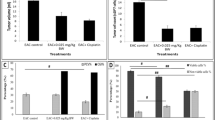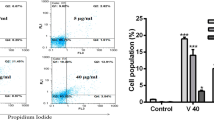Abstract
Many active principles produced by animals, plants and microorganisms have been employed in the development of new drugs for the treatment of human diseases. Among animals known to produce pharmacologically active molecules that interfere in human cell physiology, the caterpillar Lonomia obliqua has become the focus of toxicological studies due to recent findings about its venom constituents. The objective of this study was to investigate the effects of L. obliqua venom upon the viability and the proliferation of different cell lineages and to propose mechanisms for the herein observed induction of cell proliferation in glioma cell lines. MTT analyses indicate that L. obliqua venom increases the viability of tumor cell lines U138-MG and HT-29; on the other hand, it inhibits the viability of V-79 nontumor cells. Cell count based on the trypan blue exclusion method suggests a proliferating activity of the venom upon U138-MG cells. Exposure of U138-MG to crude venom extract led to a decrease in the production of nitric oxide, and activation of the cAMP signaling pathway inhibited the effects of the venom, indicating that these mechanisms may influence cell proliferation triggered by the venom. Despite the proliferative effects of crude venom on U138-MG and HT-29 cell cultures, a protein purified from L. obliqua hemolymph previously shown to have cytoprotective activity had no effect on U138-MG and HT-29; however, this same protein increased the viability of V-79 cells that had previously been exposed to the cytotoxic activity of the crude venom extract. This study indicates that the venom and the antiapoptotic protein act differently and have different effects on cell cultures, depending on the cell line analyzed. Biomolecules displaying either mitogenic or cytotoxic activities are of great biotechnological interest. Further studies encompassing the purification of active principles from L. obliqua venom are necessary to further elucidate its effects on different cell types.







Similar content being viewed by others
References
Alvarez Flores MP, Fritzen M, Reis CV, Chudzinski-Tavassi AM (2006) Losac, a factor X activator from Lonomia obliqua bristle extract: its role in the pathophysiological mechanisms and cell survival. Biochem Biophys Res Commun 343:1216–1223
Apel A, Groth A, Schlesinger S, Bruns H, Schemmer P, Büchler MW, Herr I (2009) Suitability of human mesenchymal stem cells for gene therapy depends on the expansion medium. Exp Cell Res 315:498–507
Carmo ACV, Giovanni DNS, Corrêa TP, Martins LM, Stocco RC, Suazo CAT, Moraes RHP, Veiga ABG, Mendonça RZ (2012) Expression of an antiviral protein from Lonomia obliqua hemolymph in baculovirus/insect cell system. Antiviral Res 94:126–130
Chudzinski-Tavassi AM, Alvarez Flores MPA (2005) Exploring new molecules and activities from Lonomia obliqua caterpillars. Pathophysiol Haemost Thromb 34:228–233
Chung CY, Chen CY, Lin SY, Chung YC, Chiu HY, Chi WK, Lin YL, Chiang BL, Chen WJ, Hu YC (2010) Enterovirus 71 virus-like particle vaccine: improved production conditions for enhanced yield. Vaccine 28:6951–6957
D’Andrea F, De Francesco F, Ferraro GA, Desiderio V, Tirino V, De Rosa A, Papaccio G (2008) Large-scale production of human adipose tissue from stem cells: a new tool for regenerative medicine and tissue banking. Tissue Eng Part C Methods 14:233–242
Duarte AC, Crusius PS, Pires CA, Schilling MA, Fan HW (1996) Intracerebral haemorrhage after contact with Lonomia caterpillars. Lancet 348:1033
Farias CB, Lima RC, Lima LO, Flores DG, Meurer L, Brunetto AL, Schwartsmann G, Roesler R (2008) Stimulation of proliferation of U138-MG glioblastoma cells by gastrin-releasing peptide in combination with agents that enhance cAMP signaling. Oncology 75:27–31
Fritzen M, Flores MP, Reis CV, Chudzinski-Tavassi AM (2005) A prothombin activator (Lopap) modulatin inflammation, coagulation and cell survival mechanisms. Biochem Biophys Res Commun 333:68–74
Jacques-Silva MC, Bernardi A, Rodnight R, Lenz G (2004) ERK, PKC and PI3 K/Akt pathways mediate extracellular ATP and adenosine-induced proliferation of U138-MG human glioma cell line. Oncology 67:450–459
Jadeski LC, Chakraborty C, Lala PK (2002) Role of nitric oxide in tumour progression with special reference to a murine breast cancer model. Can J Physiol Pharmacol 80:125–135
Kelen EMA, Picarelli ZP, Duarte AC (1995) Hemorrhagic syndrome induced by contact with caterpillars of the genus Lonomia (Saturniidae, Hemileucinae). J Toxicol Toxin Rev 14:283–308
Kurimoto M, Endo S, Hirashima Y, Hamada H, Oguchi T, Takaku A (1999) Growth inhibition and radiosensitization of cultured glioma cells by nitric oxide generating agents. J Neuro-Oncol 42:35–44
Maranga L, Mendonça RZ, Bengala A, Peixoto CC, Moraes RH, Pereira CA, Carrondo MJ (2003) Enhancement of Sf-9 cell growth and longevity through supplementation of culture medium with hemolymph. Biotechnol Prog 19:58–63
Mendonça RZ, Greco KN, Sousa AP, Moraes RH, Astray RM, Pereira CA (2008) Enhancing effect of a protein from Lonomia obliqua hemolymph on recombinant protein production. Cytotechnology 57:83–91
Morrone FB, Jacques-Silva MC, Horn AP, Bernardi A, Schwartsmann G, Rodnight R, Lenz G (2003) Extracellular nucleotides and nucleosides induce proliferation and increase nucleoside transport in human glioma cell lines. J Neurooncol 64:211–218
Pinto AFM, Silva KRLM, Guimarães JA (2006) Proteases from Lonomia obliqua venomous secretions: comparison of procoagulant fibrin(ogen)olytic and amidolytic activities. Toxicon 47:113–121
Pinto AF, Dragulev B, Guimarães JA, Fox JW (2008) Novel perspectives on the pathogenesis of Lonomia obliqua caterpillar envenomation based on assessment of host response by gene expression analysis. Toxicon 51:1119–1128
Rycyzyn MA, Staquet K, Fisher J, Bannish G, Bassiri A, Duchala C, Giles-Komar J (2008) The use of an anti-CD40 agonist monoclonal antibody during immunizations enhances hybridoma generation. Hybridoma 27:25–30
Seibert CS, Shinohara EM, Sano-Martins IS (2003) In vitro hemolityc activity of Lonomia obliqua caterpillar bristle extract on human and Wistar rat erytrocytes. Toxicon 41:831–839
Seibert CS, Tanaka-Azevedo AM, Santoro ML, Mackessy SP, Soares Torquato RJ, Lebrun I, Tanaka AS, Sano-Martins IS (2006) Purification of a phospholypase A2 from Lonomia obliqua caterpillar bristle extract. Biochem Biophys Res Commun 342:1027–1033
Souza AP, Peixoto CC, Maranga L, Carvalhal AV, Moraes RH, Mendonça RM, Pereira CA, Carrondo MJ, Mendonça RZ (2005) Purification and characterization of an anti-apoptotic protein isolated from Lonomia obliqua hemolymph. Biotechnol Prog 21:99–105
Veiga ABG, Blochtein B, Guimarães JA (2001) Structures involved in production, secretion and injection of the venom produced by the caterpillar Lonomia obliqua (Lepidoptera, Saturniidae). Toxicon 39:1343–1351
Veiga ABG, Pinto AFM, Guimarães JA (2003) Fibrinogenolytic and procoagulant activities in the hemorrhagic syndrome caused by Lonomia obliqua caterpillars. Thromb Res 111:95–101
Veiga AB, Ribeiro JM, Guimarães JA, Francischetti IM (2005) A catalog for the transcripts from the venomous structures of the caterpillar Lonomia obliqua: identification of the proteins potentially involved in the coagulation disorder and hemorrhagic syndrome. Gene 355:11–27
Veiga ABG, Berger M, Guimarães JA (2009) Lonomia obliqua venom: pharmaco-toxicological effects and biotechnological perspectives. In: De Lima ME (ed) Animal toxins: state of the art: perspectives in health and biotechnology. Belo Horizonte, UFMG, pp 372–390
Viani P, Giussani P, Brioschi L, Bassi R, Anelli V, Tettamanti G, Riboni L (2003) Ceramide in nitric oxide inhibition of glioma cell growth. J Biol Chem 278:9592–9601
Waismam K, Chudzinski-Tavassi AM, Carrijo-Carvalho LC, Pacheco MT, Farsky SH (2009) Lopap: a non-inflammatory and cytoprotective molecule in neutrophils and endothelial cells. Toxicon 53:652–659
Weyerbrock A, Baumer B, Papazoglou A (2009) Growth inhibition and chemosensitization of exogenous nitric oxide released from NONOates in glioma cells in vitro. J Neurosurg 110:128–136
Wood FM, Kolybaba ML, Allen P (2006) The use of cultured epithelial autograft in the treatment of major burn wounds: eleven years of clinical experience. Burns 32:538–544
Wurm FM (2004) Production of recombinant protein therapeutics in cultivated mammalian cells. Nat Biotechnol 32:1393–1398
Acknowledgments
We thank the Brazilian agency CAPES (Ministry of Education) for the fellowship to T.E. Heinen. We thank the Federal University of Health Sciences of Porto Alegre (UFCSPA) and the University Hospital Research Center (HCPA) for encouragement and support. We express special thanks to Dr. R.Z. Mendonça for kindly providing the antiapoptotic protein isolated from L. obliqua hemolymph. Last, but not least, this study would not have been possible without the collaboration of the Fire Department of the city of Erechim (Rio Grande do Sul, Brazil) and the Municipal Sanitary Surveillance Division of the city of Videira (Santa Catarina, Brazil), that provided the L. obliqua specimens used.
Conflict of interest
The authors declare that there are no conflicts of interest.
Author information
Authors and Affiliations
Corresponding author
Rights and permissions
About this article
Cite this article
Heinen, T.E., de Farias, C.B., Abujamra, A.L. et al. Effects of Lonomia obliqua caterpillar venom upon the proliferation and viability of cell lines. Cytotechnology 66, 63–74 (2014). https://doi.org/10.1007/s10616-013-9537-7
Received:
Accepted:
Published:
Issue Date:
DOI: https://doi.org/10.1007/s10616-013-9537-7




